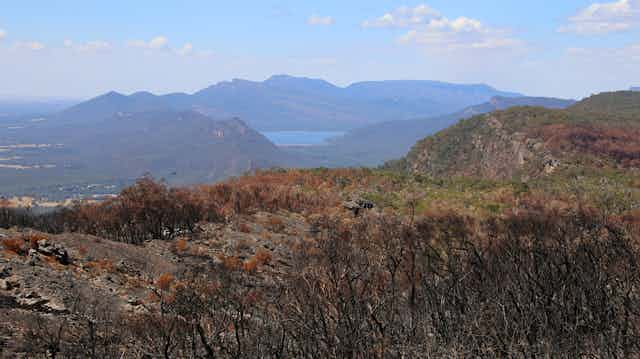Our EcoCheck series takes the pulse of some of Australia’s most important ecosystems to find out if they’re in good health or on the wane.
The Grampians National Park is a large conservation reserve, sprawling across 168,000 hectares embedded in western Victoria’s agricultural landscape. With a rich cultural heritage and regionally important flora and fauna, it is a hugely significant area for conservation. But in recent years it has been subjected to a series of major wildfire events, a flood, and long periods of low rainfall.
Our research shows that this has sent small mammal populations on the kind of boom-and-bust rollercoaster ride usually seen in arid places, not temperate forests.
The fire and the flood
We began studying the Grampians in 2008, investigating how small mammals had responded to a catastrophic wildfire that burned half of the national park in 2006. What started as a one-year study has turned into a long-term research program to investigate how the past few years of hypervariable rainfall and heightened bushfire activity have affected the animals that live in the park.
Fortunately (for our study, at least), the beginning of our research in 2008 was in the middle of a long run of very poor rainfall years, as the Millennium Drought reached its height. The drought was broken at the end of 2010 by the Big Wet, which led to well-above-average rainfall and floods in the Grampians.
But soon after, rainfall rapidly dipped back to below average. It has stayed there ever since. We also saw two more major fire events, in 2013 and 2014, which together with the 2006 fire burned some 90% of the Grampians landscape.

The reason this is fortunate from a scientific point of view is that this sequence of events has mimicked almost exactly the predictions of what climate change will bring.
We believe the Grampians is offering us a lens through which to look at future climate conditions and at how ecosystems will respond.
Animals on the wane
We have monitored small mammal communities at 36 sites throughout the Grampians each year since 2008. The system exhibited extremely slow recovery after the 2006 wildfires, with the mammal community dominated by the introduced house mouse.
Then all of a sudden, in 2011 and particularly 2012, the system went boom. Mammal numbers almost trebled. We were seeing species in areas where we had never found them before, and populations were flourishing.
It was amazing. But almost as fast as the system went up, it crashed back to low numbers again by 2013 and has stayed that way since.

This boom and bust is not something we would expect to see in a temperate forest ecosystem such as the Grampians. It is more like what you would expect to see in arid ecosystems.
It is clear that rainfall is incredibly important for the region’s small mammal communities. If the rain turns off, mammal numbers decline and they retreat to areas that offer enough resources for them to survive.
The rain is a critical bottom-up driver of this ecosystem, because it sparks plant growth, which in turn encourages invertebrates. Mammals depend on both for food.
The climate question
How can these findings inform us about the potential impacts of climate change? Maybe we need to look at what the broad predictions are for future climate conditions in southeast Australia. What we can expect is a general reduction in rainfall, with rainfall in many years falling well below long-term averages, punctuated by extreme rainfall events and floods.
We can also expect to see much more fire activity, with more frequent, bigger and more intense bushfires.
Our research suggests that places like the Grampians, which we thought would be fairly resilient to climate change, may be in far more trouble than we thought. We could potentially lose species entirely if the dry periods continue for too long.
Possibly more troubling is the potential interplay between flood events and subsequent fires.
Effectively, the flood events could be promoting fires. While this sounds counterintuitive, floods drive rapid vegetation growth and recovery, effectively priming the landscape for severe fires once rainfall dwindles again.
We saw this in 2013 and 2014, with major fires following on the heels of the 2011 floods. While fire is not a bad thing for ecosystems, our research has highlighted the critical importance of having a lot of long-unburnt vegetation in the system to promote the best conditions for mammal communities.
Unfortunately, the system has extremely limited long-unburnt vegetation. If climate change pans out in a similar way to what we have seen in the Grampians, the capacity for ecosystems to maintain such vegetation will be compromised, with worrying implications for native wildlife.
At this stage, the long-term prognosis for the health of the Grampians ecosystem is mixed. With very little long-unburnt vegetation, many small mammals will struggle until the vegetation ages. They may be waiting a long time if future rainfall and bushfire projections are accurate.
We commented earlier on how lucky we have been in getting such hypervariable rainfall conditions across the duration of our research. We could not have shown that a system like the Grampians is acting like an arid boom-bust system if we had not decided to take a long-term approach.
Long-term studies like this, however, are rare in Australia and most of our knowledge is thus limited to mere snapshots. If we had conducted typical short-term studies looking at the response of mammals to fire in 2009 versus 2012, we would have missed the intervening boom.
In the face of emerging climate change, we need to foster more long-term ecological research programs around Australia in different landscape types.
You can follow this research project on Twitter at @Wild_Gramps.
And if you’re a researcher who studies an iconic Australian ecosystem and would like to give it an EcoCheck, get in touch.

